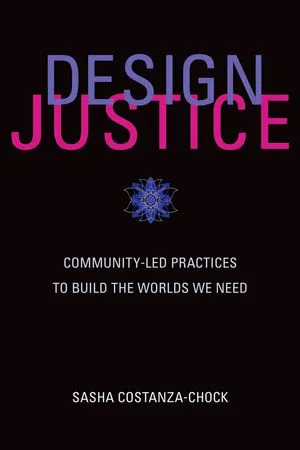
Design Justice : Community-Led Practices to Build the Worlds We Need
- English
- PDF
- Available on iOS & Android
Design Justice : Community-Led Practices to Build the Worlds We Need
About this book
What is the relationship between design, power, and social justice? "Design justice" is an approach to design that is led by marginalized communities and that aims expilcitly to challenge, rather than reproduce, structural inequalities. It has emerged from a growing community of designers in various fields who work closely with social movements and community-based organizations around the world.This book explores the theory and practice of design justice, demonstrates how universalist design principles and practices erase certain groups of people—specifically, those who are intersectionally disadvantaged or multiply burdened under the matrix of domination (white supremacist heteropatriarchy, ableism, capitalism, and settler colonialism)—and invites readers to "build a better world, a world where many worlds fit; linked worlds of collective liberation and ecological sustainability." Along the way, the book documents a multitude of real-world community-led design practices, each grounded in a particular social movement. Design Justice goes beyond recent calls for design for good, user-centered design, and employment diversity in the technology and design professions; it connects design to larger struggles for collective liberation and ecological survival.
Frequently asked questions
- Essential is ideal for learners and professionals who enjoy exploring a wide range of subjects. Access the Essential Library with 800,000+ trusted titles and best-sellers across business, personal growth, and the humanities. Includes unlimited reading time and Standard Read Aloud voice.
- Complete: Perfect for advanced learners and researchers needing full, unrestricted access. Unlock 1.4M+ books across hundreds of subjects, including academic and specialized titles. The Complete Plan also includes advanced features like Premium Read Aloud and Research Assistant.
Please note we cannot support devices running on iOS 13 and Android 7 or earlier. Learn more about using the app.
Information
Table of contents
- Contents
- Acknowledgments
- Series Editor’s Introduction
- Preface
- Introduction: #TravelingWhileTrans, Design Justice, and Escape from the Matrix of Domination
- 1: Design Values: Hard-Coding Liberation?
- 2: Design Practices: “Nothing about Us without Us”
- 3: Design Narratives: From TXTMob to Twitter
- 4: Design Sites: Hackerspaces, Fablabs, Hackathons, and DiscoTechs
- 5: Design Pedagogies: “There’s Something Wrong with This System!”
- Directions for Future Work: From #TechWontBuildIt to #DesignJustice
- Glossary
- Notes
- References
- Index